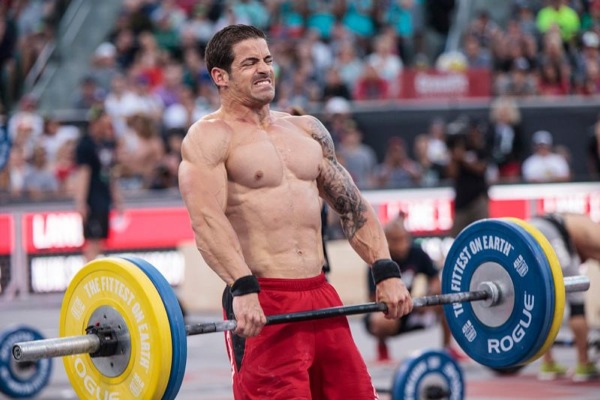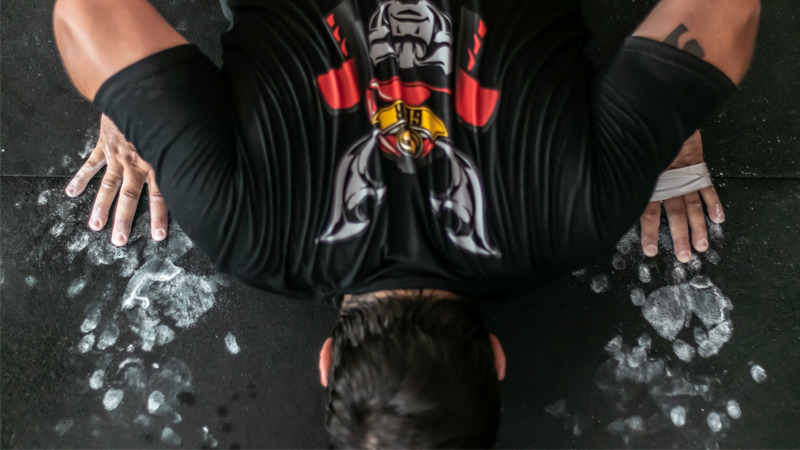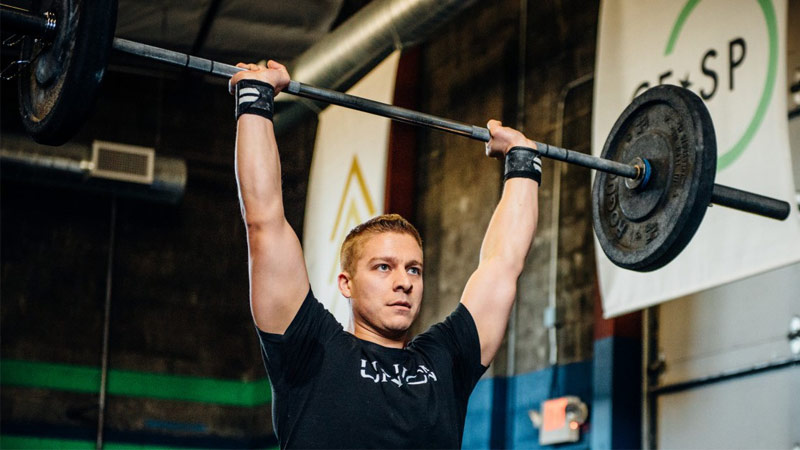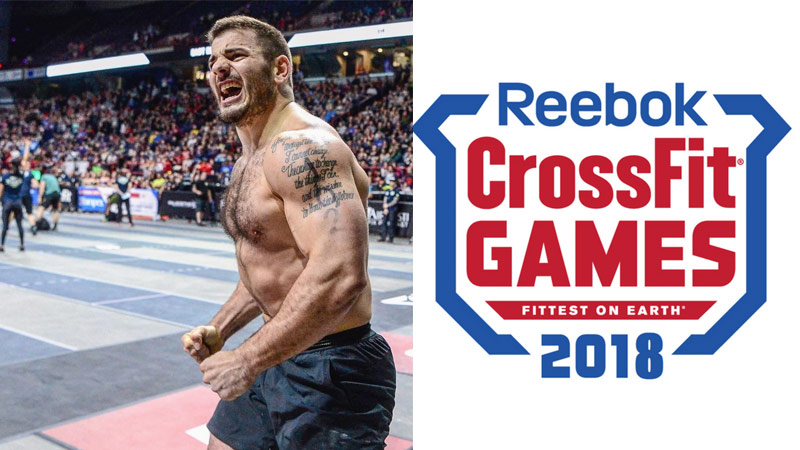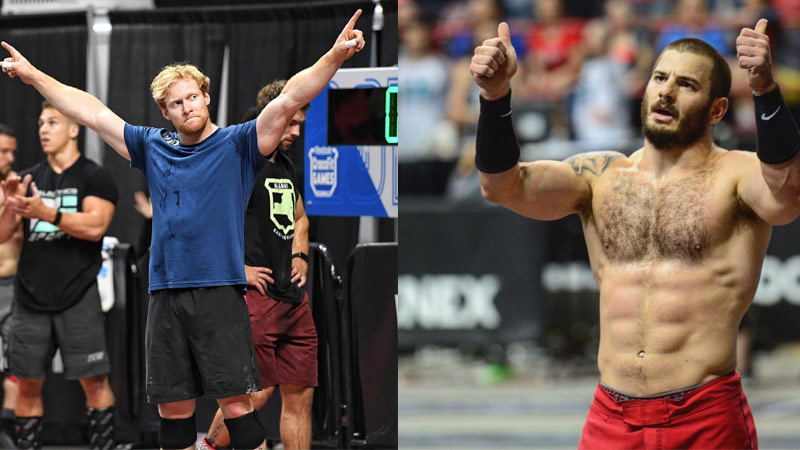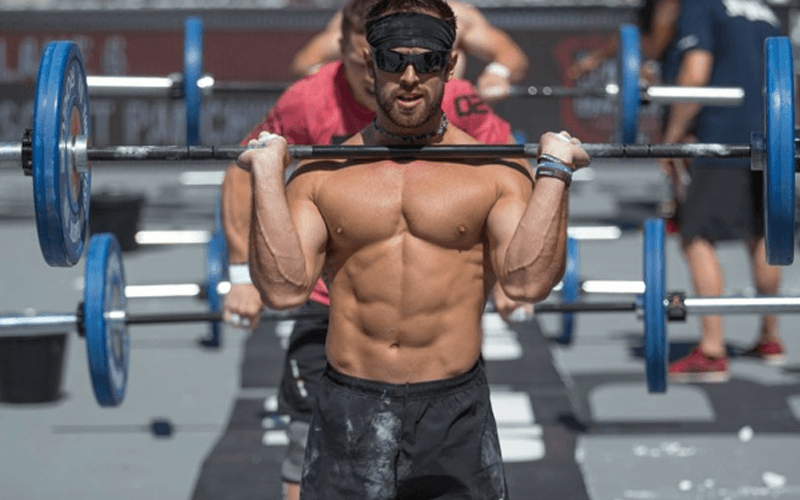
The phenomenon that is CrossFit has completely divided Strength & Conditioning coaches. On the one hand many herald Rich Froning (pictured above) as the second coming of Christ and ‘The World’s Fittest Man’. On the other, people avoid CrossFitters like the plague in fear they will catch the dreaded rhabdomyolysis, a rare condition where the muscles eat away at themselves following strength training protocols that are too high in volume, duration, and weight. So to try and shed some light on the debate, Head Sports Scientist at THE PROTEIN WORKS™ Ross Edgley attempts to explain the science of each form of training so you can decide whether to stick with the ‘Old School’ or follow Rich Froning’s latest master class in this month’s Muscle Mag.
VIEW ROGUE FITNESS BARBELLS
It’s Strength & Conditioning 101, to get faster, stronger, or bigger you need to load your body above its habitual level (the level it’s accustomed to doing). It’s not rocket science, it just means every time you go to the gym you need to try and do more than you did the session before. Whether that’s putting those tiny 2.5kg, ‘biscuit-like’ discs on either end of your squat, or maybe increasing the height of those box jumps, it’s important to make these small incremental gains. Now of course this is the goal of any training routine, CrossFit stands out because it proudly combines big, heavy Olympic lifts reminiscent of an Iranian Champion weightlifter’s program ,with the sort of cardio based circuit that would test a Kenyan marathon runner. Whereas conventional training places a greater emphasis on ‘periodization’ and recovery. Often separating cardio and strength training whilst at the same time cycling heavy, compound lifts once a week (or month) and recommending a ‘de-load’ lighter week to prevent over training (a concept alien to most CrossFitters). Now I’m not pointing the finger and saying one is better than the other, instead I’d prefer to explain the science of what happens in the body during both forms of training as impartially as possible.
Immune System:
The main mantra of Crossfit is to deplete, endure, and repeat. The only problem is this type of balls-out, constant high intensity, heavy load training puts a lot of stress on the body and can lead to overtraining. This is where your immune system is suppressed, your central nervous system is fried, and your neurotransmitters are exhausted. Whereas conventional, ‘old school’ training emphasizes ‘periodization’ and the systematic planning of your training with set cycles. So 1 week hard, 1 week easy, 1 week medium (a very basic cycle). But what exactly happens inside the body during a savage CrossFit session that makes it so bad for the immune system?
Firstly there’s a well quoted study that was done at the Department of Human Movement Studies at the University of Queensland where researchers decided to determine the exact effects training intensity had on the immune system. What they did was measure certain key ‘immune system parameters’ in athletes and then subjected them to a pretty brutal training regime (reminiscent of Crossfit). What they found was that really high intensity training drastically altered certain immune factors within the body which in turn influenced an athlete’s resistance to infection and disease. What they experienced was an exercise induced ‘immune crash’ (L.T. Mackinnon, 1997). The main immune system parameter that was affected was circulating leukocytes (these are perhaps better known as ‘white blood’ cells) which have the primary job of protecting the body against foreign invaders such as microorganisms causing infection. To use a sports metaphor, this is like trying to defend with 4 less players on the field (white blood cells/ leukocytes) compared to your opposition (the infection/ bacteria). Granted you could put up a decent fight, but chances are you’d lose and the opposition (bacteria) would win (you become ill and miss leg day).
In that same study at the University of Queensland it was also found that plasma cytokine concentrations were also badly affected by high intensity training. Cytokines are known as the ‘messengers’ of the immune system and they are basically any substance that’s secreted by specific cells in the immune system that carry signals between other cells. They’re so important to the day to day functioning of both the innate (natural/ normal) immune system and the adaptive immune response (that which kicks in when under attack from infection). When effected it means the communication across the entire immune system is flawed (R. Gokhale et al, 2007). To use a different metaphor this is like trying to get a girls number in the gym whilst being gagged with a sock so communication is more difficult. If you’ve got good game you might stand a chance, but in reality she’s going to wonder who the weirdo with a sock in his mouth is and walk off.
As a concluding thought to the immune system and Conventional Vs CrossFit training, it seems scientifically it’s the ‘old-school’ method of periodisation that would be best to prevent this ‘immune crash’. Particularly important for those who are prone to overtraining and who need to take better care of their immune system. But (and just to throw a counter argument out there) some people can undergo a far greater volume of training and not get ill and in some cases actually require this huge volume of training to progress. To quote the legend that is C.T. Fletcher ‘Overtraining is a mother f@#king good thing’. Although not a CrossFitter himself, he clearly has no regard for this ‘old-school’ method of periodisation and he’s also a very, very strong man.
Hormonal Response:
Another thing to consider is the hormonal response to each form of training. Firstly it’s common knowledge that heavy compound movements increase testosterone levels. So much so at the Human Performance Laboratory at Ball State University, Muncie, it was found that ‘strength training can induce testosterone release, regardless of age.’ Going into a little more detail typically experts recommend including heavy compound movements like squat, bench and dead lift in your workouts, with 90 seconds or more rest between sets, lifting at 85% of your maximum weight and for a gym session lasting no more than 60 minutes to induce the biggest release of testosterone.
CrossFit is obviously very different and in fact walks the line between endurance and strength. This has been shown to increase cortisol levels, reduce testosterone and possibly lead to muscle breakdown. In study conducted in Spain at the Athletic Club of Bilbao researchers wanted to specifically look into how hormones and exercise intensity effect the immune system. They examined key hormonal markers such as 24-hour urinary cortisol : cortisone ratio, testosterone : cortisol ratio, testosterone and cortisol on their own and lastly plasma catecholamines, insulin-like growth factor-1 and growth hormone (S. Padilla 2004) during periods of long, intense, high intensity training again reminiscent of CrossFit. What they found was such training dramatically brought about a change in the hormonal environment within the body, an environment that wasn’t particularly suited to building muscle and also one that allowed pathogens (disease producing agents) to thrive and multiply. Scientists cited a rise in cortisol levels for this change, a catabolic hormone that affects muscle mass and also suppresses T-cell cytokine production (as we know cytokines are essential for a healthy immune system). What this means is your left ill, weak and with your biceps wasting away.
But again just to impartially pose another counter argument in favour of CrossFit, high intensity training with minimal rest is also found to stimulate another muscle building hormone in the form of Growth Hormone. A hormone secreted by a tiny grape sized organ called the anterior pituitary gland, this hormone plays a huge role in building muscle and it’s the CrossFit style training that best causes it’s release within the body through a mechanism known as Exercise Induced Growth Hormone Release (EIGR). It does this by stimulating neural input, catecholamines, lactic acid and nitric oxide as well as in response to the changing overall acid-base balance within the body.
Fat Loss:
Another point to consider is the impact both kinds of training has on body fat levels. One thing that’s evident when watching the CrossFit games is that rarely do you see body fat over 12% (on both the men and women). This could be perhaps best explained by research conducted at the Physical Activity Sciences Laboratory at Laval University, Québec, Canada that compared exercise intensities and their effect on lipid (fat balance) and body fat levels. What they found was higher intensity training produced metabolic adaptations that greatly favoured the process of lipid oxidation (fat oxidisation) compared to steady, moderate cardio.
Again that’s not to say Phil Heath should have chopped the hours of steady, lethargic cardio on the static bike before the 2013 Mr Olympia and instead should have busted out some circuit training on the rings to get shredded. But it does mean that CrossFit will get you cut and if you’re not a fan of it, the idea of incorporating some High Intensity Interval Training into your ‘old-school’ conventional training may not be a bad one.
References:
- Nieman (2003) Medicina Sportive, 7, pp. E19-28 ‘Potential nutritional countermeasures to exercise–induced immunosuppression’
- Pyne et al (2000) International Journal of Sports Medicine. May, 21 Suppl 1, pp. S51-60 ‘Training strategies to maintain immuno-competence in athletes’
- Gleeson et al (2004) Journal of Sports Sciences, 22, pp. 115-25. ‘Exercise, nutrition and immune function’
- Brolinson & Elliot (2007) Clinical Sports Medicine. 26(3),311-319 ‘Exercise and the immune system.’
- Gleeson (2007) Journal Apply Physiology,103(2),693-699 ‘Immune function in sport and exercise.’
- Gleeson (2006) Current Opinion in Clinical Nutrition and Metabolic Care, 9(6), 659-665 ‘Immune system adaptation in elite athlete.’
- Gleeson, Nieman & Pedersen (2004) Journal Sports Science,22(1), 115-125 ‘Exercise, nutrition and immune function.’
- Mujika, Padilla, Pyne and Busso (2004) Sports Medicine, 34(13), 891-927 ‘Physiological changes associated with pre-event taper in athletes.’
- D.C Nieman et al (1990) International Journal of Sports Medicine,11,467-73 ‘The effects of moderate exercise training on natural-killer-cells and acute upper respiratory-tract infections.’
- H.B. Nielsen (2003) Sports Medicine, 33,853-67 ‘Lymphocyte responses to maximal exercise: a physiological perspective.’
- Pacque, Booth, Ball & Dwyer (2007) Journal of Sports Medicine and Physical Fitness. 47(4), 496-501 ‘The effect of an ultra-endurance running race on mucosal and humeral immune function.’
- Pedersen & Toft (2000) British Journal of Sport Medicine,34, 246-251 ‘Effects of exercise on lymphocytes and cytokines.’
- Pedersen, Rohde & Zacho (1996) International Journal of Sports Medicine,36, 236-45. ‘Immunity in athletes.’
- Gokhale, Chandrashekara and Vasanthakumar (2007) Cytokine 2007 Nov; 40(2):123-7. 2007 Oct 22. ‘Cytokine response to strenuous exercise in athletes and non-athletes–an adaptive response.’
- Heath, Ford, Craven, Macera, Jackson & Pate (1991) Medical Science in Sports and Exercise 23: 152–157 ‘Exercise and the incidence of upper respiratory tract infections.’
- Nieman, Johansen, Lee & Arabatzis (1990) The Journal of Sports Medicine and Physical Fitness, 30: 316–328, 1990 ‘Infectious episodes in runners before and after the Los Angeles Marathon.’
- Pedersen & Bruunsgaard (1995) Sports Medicine 19: 393–400, 1995 ‘How physical exercise influences the establishment of infections.’
- Spence, Brown, Pyne, Nissen, Sloots, McCormack, Locke and Fricker (2007) Medicine and Science in Sport and Exercise. 2007 Apr;39(4):577-86. ‘Incidence, etiology, and symptomatology of upper respiratory illness in elite athletes.’
- Hirano et al (1990) International Journal of cell cloning, 1990 Jan;8 Supplement Chapter 1 Page 155-66; discussion 166-7. ‘Interleukin 6 and its receptor in the immune response and hematopoiesis.’
- Christian & Fischer et al (2004) July 15, 2004 The Journal of Physiology, 558, 633-645. ‘Supplementation with vitamins C and E inhibits the release of interleukin-6 from contracting human skeletal muscle.’
- Bassit et al (2000) Medicine and Science in Sport and Exercise, 2000 Jul;32(7):1214-9. ‘The effect of BCAA supplementation upon the immune response of triathletes.’
- Angelo Tremblay, Jean-Aimé Simoneau and Claude Bouchard (1994) ‘Impact of exercise intensity on body fatness and skeletal muscle metabolism.’ Metabolism, Volume 43, Issue 7, July 1994, Pages 814–818
